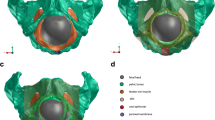Abstract
We have developed a modelling framework to simulate vaginal delivery using individual-specific pelvic floor geometries derived from magnetic resonance images, which could potentially be used to study the effect of various contributing factors (such as muscle mass and muscle tone) on the childbirth process. One important goal of this is to faithfully represent the path of the fetal head as it descends through the maternal pelvis. Previous studies have prescribed or restricted the path of the fetal head. In this study, we investigate the effect of the fetal head motion on the mechanical response of the pelvic floor muscle by applying three types of constraints to the fetal head: (1) a completely prescribed head path; (2) allowing rotation about one point on the head; and (3) a minimally constrained head, allowing both rotation and translation. The results were analysed by comparing the normalised reaction forces exerted on the fetal head and the maximum principal stretch ratios of the pelvic floor muscles. The reaction forces for case (3) were markedly reduced compared to cases (1) and (2), indicating that the path of the fetal head has significant influence on the force required to achieve delivery. These results also indicate that models should use a minimally constrained fetal head so that its path is determined by the geometry of the head and the pelvic floor. Future work will introduce nonlinearity and anisotropy into the pelvic floor muscles and use this modelling framework to compare the mechanical response between athlete and non-athlete in order to determine the factors that contribute to difficulties during the second stage of labour for athletic mothers.
Access this chapter
Tax calculation will be finalised at checkout
Purchases are for personal use only
Similar content being viewed by others
Notes
- 1.
An interactive computer program for Continuum Mechanics, Image analysis, Signal processing and System Identification, http://www.cmiss.org/
References
Varney, H., Kriebs, J.M., Gegor, C.L.: Varney’s midwifery, 14th Ed. Jones and Bartlett Pub., Sudbury (2004)
Smellie, W., Hamilton, A.: A set of anatomical tables, with explanations: and an abridgment of the practice of midwifery. London (1793)
Borell, U., Fernstrom, I.: Shape and course of the human birth canal–a radiographic study in the human. Acta Obstetricia et Gynecologica Scandinavica, 36, 166–179 (1957b)
Borell, U., Fernstrom, I.: The movements in the mechanism of disengagement with special reference to the attitude of the foetal head. Acta Obstetricia et Gynecologica Scandinavica, 36, 347 (1957c)
Borell, U., Fernstrom, I.: Radiographic studies of the rotation of the foetal shoulders during labour. Acta Obstetricia et Gynecologica Scandinavica, 37, 54–61 (1958)
Borell, U., Fernstrom, I.: Internal anterior rotation of the foetal head–a contribution to its explanation. Acta Obstetricia et Gynecologica Scandinavica, 38, 103–109 (1959)
Borell, U., Fernstrom, I.: The mechanism of labour. Radiologic Clinics of North America, 5, 73–85 (1967)
Martins, J.A.C., Pato, M.P.M., Pires, E.B., Jorge, R.M.N., Parente, M., Mascarenhas, T.: Finite element studies of the deformation of the pelvic floor. Annals of the New York Academy of Sciences, 1101(1), 316–334 (2007)
Lien, K., Mooney, B., DeLancey, J.O.L., Ashton-Miller, J.A.: Levator ani muscle stretch induced by simulated vaginal birth. The American College of Obstetricians and Gynecologists, 103(1), 31–40 (2004)
Hoyte, L., Damaser, M.S., Warfield, S.K., Chukkapalli, G., Majumdar, A., Choi, D.J., Trivedi, A., Krysl, P.: Quantity and distribution of levator ani stretch during simulated vaginal childbirth. American Journal of Obstetrics & Gynecology, 199(2), 198.e1–198.e5 (2008)
Li X., Kruger, J., Chung, J., Nash, M.P., Nielsen, P.M.F.: Modelling childbirth: Comparing athlete and non-athlete pelvic floor mechanics. In: Lecture Notes in Computer Science: Medical Image Computing and Computer-Assisted Intervention MICCAI 2008. Springer, Berlin/Heidelberg, pp.750–757 (2008)
Kruger, J.A., Heap, S.W., Murphy, B.A., Dietz, H.P.: Pelvic floor function in nulliparous women using three-dimensional ultrasound and magnetic resonance imaging. Obstetrics & Gynecology, 111(3), 631–638 (2008)
Li, X., Kruger, J., Chung, J., Nash, M.P., Nielsen, P.M.F.: Modelling the pelvic floor for investigating difficulties during childbirth. Proceedings of SPIE, 6916(69160 V), (2008)
Lapeer, R.J., Prager, R.W.: Fetal head moulding: finite element analysis of a fetal skull subjected to uterine pressures during the first stage of labour. Journal of Biomechanics, 34, 1125–1133 (2001)
Laursen, T.A.: Computational contact and impact mechanics, 1st Ed. Springer, Berlin (2002)
Chung, J.: Modelling mammographic mechanics. PhD thesis, University of Auckland, New Zealand (2008)
Chung, J., Rajagopal, V., Laursen, T.A., Nielsen, P.M.F., Nash, M.P.: Frictional contact mechanics methods for soft materials: application to tracking breast cancers. Journal of Biomechanics, 41(1), 69–77 (2008)
Lee, S., Darzi, A., Yang, G.: Subject specific finite element modelling of the levator ani. Medical Image Computing and Computer-Assisted Intervention, 8, 360–367 (2005)
Author information
Authors and Affiliations
Corresponding author
Editor information
Editors and Affiliations
Rights and permissions
Copyright information
© 2010 Springer Science+Business Media, LLC
About this paper
Cite this paper
Li, X., Kruger, J.A., Nash, M.P., Nielsen, P.M. (2010). Effects of Fetal Head Motion on Pelvic Floor Mechanics. In: Miller, K., Nielsen, P. (eds) Computational Biomechanics for Medicine. Springer, New York, NY. https://doi.org/10.1007/978-1-4419-5874-7_14
Download citation
DOI: https://doi.org/10.1007/978-1-4419-5874-7_14
Published:
Publisher Name: Springer, New York, NY
Print ISBN: 978-1-4419-5873-0
Online ISBN: 978-1-4419-5874-7
eBook Packages: EngineeringEngineering (R0)




